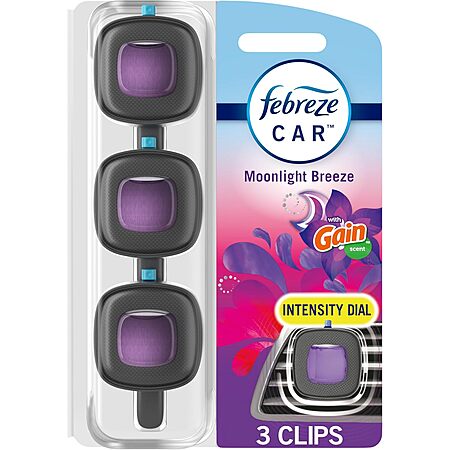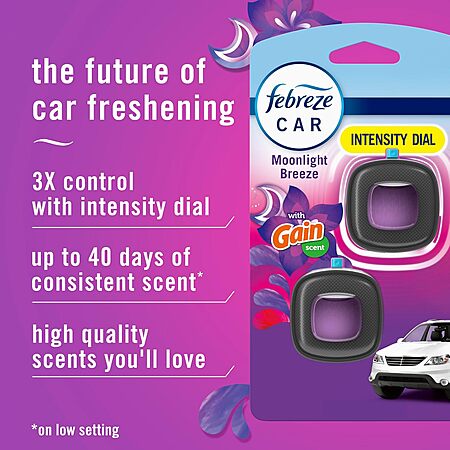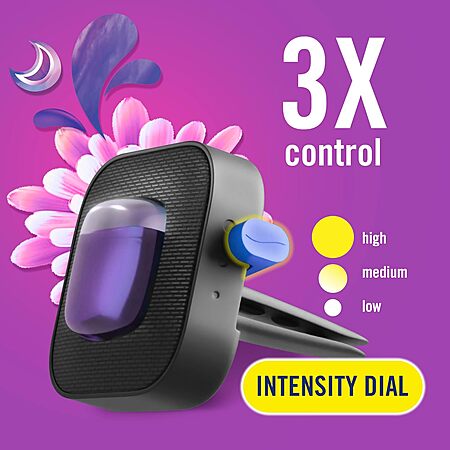popularphoinix | Staff posted Today 11:48 AM
Item 1 of 4
Item 1 of 4
popularphoinix | Staff posted Today 11:48 AM
$4.34: 3-Pack 0.07-Oz Febreze Car Air Freshener Vent Clip at Amazon
$4.34
$7.89
44% offAmazon
Get Deal at AmazonGood Deal
Bad Deal
Save
Share




Leave a Comment
4 Comments
Sign up for a Slickdeals account to remove this ad.
Here's a more detailed look at the potential dangers:
1. Volatile Organic Compounds (VOCs):
Air fresheners are known to emit a wide range of VOCs, some of which are classified as hazardous air pollutants, carcinogens, or substances linked to adverse health effects.
Examples include formaldehyde, benzene, toluene, and xylene, which can cause respiratory irritation, headaches, dizziness, and nausea.
Long-term exposure to certain VOCs has been linked to an increased risk of certain cancers.
VOCs can react with other pollutants in the air to form harmful secondary pollutants, further impacting indoor air quality.
2. Phthalates:
Many air fresheners contain phthalates, which are used as fragrance carriers and can disrupt hormone function.
Phthalates have been linked to reproductive issues, birth defects, and lower sperm counts.
3. Other Harmful Chemicals:
Air fresheners may also contain chemicals like 1,4-dichlorobenzene, which has been linked to lung damage and reduced lung function.
Aerosol air fresheners often contain propellants like butane and propane, which can irritate the respiratory system and contribute to indoor air pollution.
Naphthalene, found in some air fresheners, has been linked to tissue damage and cancer in laboratory studies.
4. Impact on Health:
Exposure to air fresheners has been associated with respiratory issues, including asthma, reduced lung capacity, and allergy aggravation.
Some studies have linked the use of air fresheners to headaches, dizziness, and nausea.
Pregnant women and individuals with pre-existing respiratory conditions, weakened immune systems, or sensitivities to chemicals may be particularly vulnerable to the adverse effects of air fresheners.
5. Alternatives:
Natural ventilation:
Opening windows and doors to allow fresh air circulation is a simple and effective way to reduce indoor air pollution.
Baking soda:
Baking soda can absorb odors naturally and is a safe and effective alternative.
Coffee grounds or lemon peels:
These can also help neutralize odors in a natural way.
Natural fragrance oils or essential oils:
Opt for air fresheners made with natural ingredients and essential oils that are free from harmful chemicals.
Air purifiers:
Air purifiers with HEPA filters can help remove pollutants and improve indoor air quality
Is it me or did the potency of these change? Moonlight Breeze was my go to and now I have the scent slider full open and can't really tell it's there even when it's stuck right in the vent.
Here's a more detailed look at the potential dangers:
1. Volatile Organic Compounds (VOCs):
Air fresheners are known to emit a wide range of VOCs, some of which are classified as hazardous air pollutants, carcinogens, or substances linked to adverse health effects.
Examples include formaldehyde, benzene, toluene, and xylene, which can cause respiratory irritation, headaches, dizziness, and nausea.
Long-term exposure to certain VOCs has been linked to an increased risk of certain cancers.
VOCs can react with other pollutants in the air to form harmful secondary pollutants, further impacting indoor air quality.
2. Phthalates:
Many air fresheners contain phthalates, which are used as fragrance carriers and can disrupt hormone function.
Phthalates have been linked to reproductive issues, birth defects, and lower sperm counts.
3. Other Harmful Chemicals:
Air fresheners may also contain chemicals like 1,4-dichlorobenzene, which has been linked to lung damage and reduced lung function.
Aerosol air fresheners often contain propellants like butane and propane, which can irritate the respiratory system and contribute to indoor air pollution.
Naphthalene, found in some air fresheners, has been linked to tissue damage and cancer in laboratory studies.
4. Impact on Health:
Exposure to air fresheners has been associated with respiratory issues, including asthma, reduced lung capacity, and allergy aggravation.
Some studies have linked the use of air fresheners to headaches, dizziness, and nausea.
Pregnant women and individuals with pre-existing respiratory conditions, weakened immune systems, or sensitivities to chemicals may be particularly vulnerable to the adverse effects of air fresheners.
5. Alternatives:
Natural ventilation:
Opening windows and doors to allow fresh air circulation is a simple and effective way to reduce indoor air pollution.
Baking soda:
Baking soda can absorb odors naturally and is a safe and effective alternative.
Coffee grounds or lemon peels:
These can also help neutralize odors in a natural way.
Natural fragrance oils or essential oils:
Opt for air fresheners made with natural ingredients and essential oils that are free from harmful chemicals.
Air purifiers:
Air purifiers with HEPA filters can help remove pollutants and improve indoor air quality
Leave a Comment